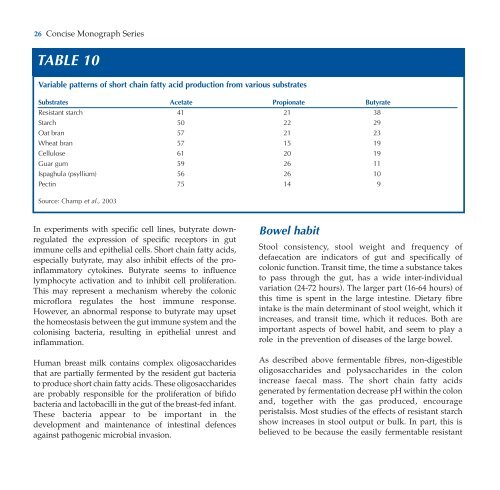Dietary Fibre - ILSI Argentina
Dietary Fibre - ILSI Argentina
Dietary Fibre - ILSI Argentina
Create successful ePaper yourself
Turn your PDF publications into a flip-book with our unique Google optimized e-Paper software.
26 Concise Monograph Series<br />
TABLE 10<br />
Variable patterns of short chain fatty acid production from various substrates<br />
Substrates Acetate Propionate Butyrate<br />
Resistant starch 41 21 38<br />
Starch 50 22 29<br />
Oat bran 57 21 23<br />
Wheat bran 57 15 19<br />
Cellulose 61 20 19<br />
Guar gum 59 26 11<br />
Ispaghula (psyllium) 56 26 10<br />
Pectin 75 14 9<br />
Source: Champ et al., 2003<br />
In experiments with specific cell lines, butyrate downregulated<br />
the expression of specific receptors in gut<br />
immune cells and epithelial cells. Short chain fatty acids,<br />
especially butyrate, may also inhibit effects of the proinflammatory<br />
cytokines. Butyrate seems to influence<br />
lymphocyte activation and to inhibit cell proliferation.<br />
This may represent a mechanism whereby the colonic<br />
microflora regulates the host immune response.<br />
However, an abnormal response to butyrate may upset<br />
the homeostasis between the gut immune system and the<br />
colonising bacteria, resulting in epithelial unrest and<br />
inflammation.<br />
Human breast milk contains complex oligosaccharides<br />
that are partially fermented by the resident gut bacteria<br />
to produce short chain fatty acids. These oligosaccharides<br />
are probably responsible for the proliferation of bifido<br />
bacteria and lactobacilli in the gut of the breast-fed infant.<br />
These bacteria appear to be important in the<br />
development and maintenance of intestinal defences<br />
against pathogenic microbial invasion.<br />
Bowel habit<br />
Stool consistency, stool weight and frequency of<br />
defaecation are indicators of gut and specifically of<br />
colonic function. Transit time, the time a substance takes<br />
to pass through the gut, has a wide inter-individual<br />
variation (24-72 hours). The larger part (16-64 hours) of<br />
this time is spent in the large intestine. <strong>Dietary</strong> fibre<br />
intake is the main determinant of stool weight, which it<br />
increases, and transit time, which it reduces. Both are<br />
important aspects of bowel habit, and seem to play a<br />
role in the prevention of diseases of the large bowel.<br />
As described above fermentable fibres, non-digestible<br />
oligosaccharides and polysaccharides in the colon<br />
increase faecal mass. The short chain fatty acids<br />
generated by fermentation decrease pH within the colon<br />
and, together with the gas produced, encourage<br />
peristalsis. Most studies of the effects of resistant starch<br />
show increases in stool output or bulk. In part, this is<br />
believed to be because the easily fermentable resistant

















